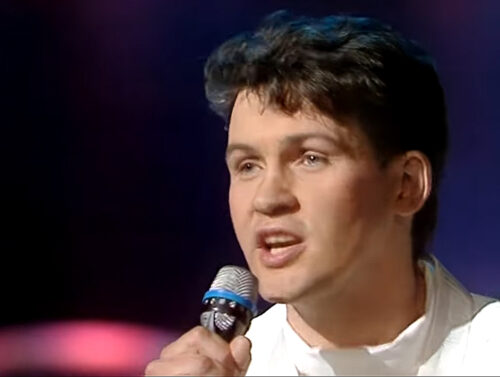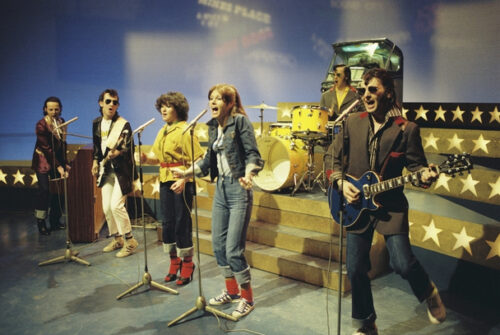We know a lot about Eurovision and we want to share this knowledge with you! Therefore we’d like to bring you a blast from the past. Today: The Swarbriggs plus Two, participating in 1977.
Ireland in the Eurovision Song Contest
Ireland has been a dominant force in the Eurovision Song Contest, boasting a record seven victories, the most by any participating country.
Their winning streak began in 1970 when Dana serenaded audiences with “All Kinds of Everything.” A decade later, Johnny Logan emerged as a Eurovision legend for Ireland. He first won in 1980 with “What’s Another Year” and then again in 1987 with “Hold Me Now.” Furthermore, Logan wrote the winning song “Why Me?” which was performed by Linda Martin in 1992.
The ’90s continued to be a golden era for Ireland. Following Linda Martin, Niamh Kavanagh captured the title in 1993 with “In Your Eyes.” The subsequent year, Paul Harrington and Charlie McGettigan triumphed with “Rock ‘N’ Roll Kids.” In 1995, Eimear Quinn’s ethereal voice won with “The Voice,” marking an unprecedented fourth consecutive victory for Ireland.

Johnny Logan
National Final
Ireland chose their entry through the Irish National Song Contest on 20 February 1977. The show was hosted by Mike Murphy and was not held in a big hall but at the RTÉ TV Studios in Dublin. Eight songs and eight different artists competed:
- Jamie Stone, “If I Give My Love”, 19 pts, 2nd
- Dickie Rock, “I Can’t Go On Without You”, 8 pts, 6th
- Sunshine, “Look Before You Leap”, 0 pts, 8th
- D.J. Curtin, “You Cannot Stop The Music”, 5 pts, 7th
- The Swarbriggs Plus Two, “It’s Nice To Be In Love Again“, 25 pts, 1st
- Denis Allen, “Da-dum Da-dum I Love You So”, 12 pts, 5th
- Colm C.T. Wilkinson, “There Was A Dream“, 18 pts, 3rd
- Chips, “Goodbye Goodbye“, 13 pts, 4th

Chips
Note that former participants Dickie Rock (1966) and The Swarbriggs (1975) participated. Colm C.T. Wilkinson had to wait another year, as he represented Ireland in 1978. The singer of the group Chips is quite a famous one: Eurovision winner Linda Martin, who first took part in 1984, before she won in 1992.
The Swarbriggs Plus Two
The Swarbriggs
Thomas “Tommy” and John James “Jimmy” Swarbrigg are renowned figures in Irish music, both as former pop artists and promoters.
In the early ’60s, Tommy showcased his trumpet skills with Joe Dolan’s showband, The Drifters, distinct from the famed American band. By 1969, after a split, The Times Showband emerged with Jimmy as the lead singer. Their distinctive approach of composing original tracks made them stand out in the showband scene. Their rise was meteoric, leading to their own TV show by 1973. By mid-’70s, they embarked on solo careers, eventually retiring in 1980.
Known as The Swarbriggs, the duo graced the 1975 Eurovision stage with “That’s What Friends Are For”. By 1977, alongside Nicola Kerr and Alma Carroll as The Swarbriggs Plus Two, they presented “It’s Nice To Be In Love Again”, a song they authored. The brothers penned both their Eurovision entries and numerous top 20 hits throughout the ’70s, such as the chart-topping “Joanne” in 1976 and other memorable tunes like “Looking Through The Eyes Of A Beautiful Girl” and “If Ma Could See Me Now”.
In subsequent years, the Swarbriggs transitioned into concert promotion, bringing to Ireland acts like Smokie, Leo Sayer, Meatloaf, and others. They’re even humorously credited as the muse for the “My Lovely Horse” video in the show “Father Ted”.
Their song “If Ma Could See Me Now” found renewed popularity, featuring in the 2002-2008 “Mrs Brown’s Boys” film series.
Nicola Kerr
Nicola Kerr was, in those days, a wellknown and asked backing vocal and member of several groups. She had been a member of Chips before she joined The Swarbriggs in their song. As a solo singer, she did two attempts to go to Eurovision: in 1981 with “The One In My Life” and in 1989 with “This Isn’t War (It’s Revolution)“. But the biggest success for Nicola was being a backing vocal for Murray Head in the worldwide hit “One Night In Bangkok”.
Alma Caroll
Alma began her musical journey at 15, performing solo in Dublin during 1965. By 1967, she joined Bing Crosby on his Dublin-filmed TV special with the “Young Dublin Singers” and even got her radio series on RTE. The next year, her song in the Irish National Song Contest, “Give Me All Your Love,” placed fourth but didn’t fare well on the charts. Alma’s TV presence grew, with appearances on shows like RTE’s “Steady As She Go-Goes” and BBC in Britain.
Despite never having a solo chart-topping hit, Alma’s prominence in the entertainment world didn’t wane. She remained active in the early ’70s, releasing singles and making TV appearances. In 1973, she placed second in the National Song Contest with “Isn’t It Grand”. A highlight of her career was being part of Swarbriggs Plus Two in 1977, where their song “It’s Nice To Be In Love Again” ranked first in Irish charts and third in Eurovision.
By the early ’80s, her performances began to wane, with her last known record in 1982. Today, Alma is married to Penney’s founder, Arthur Ryan, and is a Director for UNICEF in Ireland.
It’s Nice To Be In Love Again
The song is emblematic of the upbeat, catchy melodies often associated with Eurovision entries. With its lively tempo and harmonious vocals, “It’s Nice To Be In Love Again” captured the euphoria and bliss of being in love. The performance was well-received, earning the group a respectable third place in the contest. The song, written and composed by Jimmy and Tommy Swarbrigg, received twelve points from Norway, the United Kingdom, Israel and Sweden. Finland was the only country not to give any points to the song at all.


